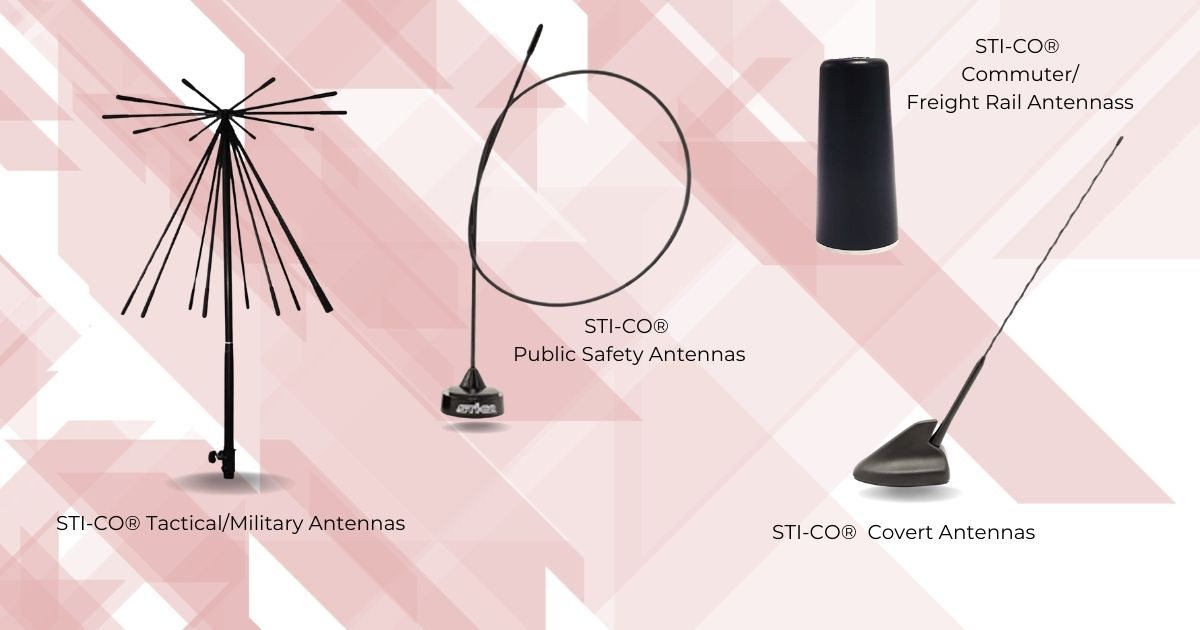Antenna Solutions From Now to Beyond
Posted by STI-CO® Antenna Solutions on 31st Aug 2023
Are you struggling with unreliable or outdated antenna systems that fail to meet your evolving needs? You're not alone; many individuals and organizations are facing rapid changes in technology that render older antenna solutions ineffective.
With decades of experience in antenna design, STI-CO has encountered and adapted to countless changes within the industry. Through it all, we’ve remained dedicated to our collaborative design process and our commitment to customer satisfaction.
This article takes those years of experience and aims to be your guide to antenna solutions, from the basic types like monopoles and dipoles to the importance of ground plane dependency.
We'll also delve into project size considerations, evolving technology, and custom vs. standard solutions.
By the end of the article, you'll have the knowledge you need to make informed decisions for your antenna system needs—whether you're looking for a single piece or planning an extensive deployment.
Understanding Different Types of Antennas
Monopoles vs. Dipoles
Two common types of antennas used are monopoles and dipoles. Monopoles are often used when space is limited and require a ground plane to function. They generally have a quarter-wavelength element above the ground and depend on the ground plane for the remaining quarter-wavelength, essentially making them a "half-wave" antenna in practice.
Dipoles, however, are often more versatile and do not necessarily require a ground plane. They are generally designed to be a half-wavelength in size and can operate either in ground-dependent or ground-independent modes.
The Importance of Ground Plane Dependency
The ground plane is an essential aspect of some antenna types, especially monopoles. It acts as a reflector that helps the antenna radiate efficiently. An essential factor to consider is the material on which the antenna will be mounted, like the roof of a bus.
A metal roof and a fiberglass roof can have drastically different impacts on the antenna's performance. Understanding whether an antenna needs to be ground plane dependent or independent helps in designing an antenna optimized for specific applications.
Project Size and Feasibility Handling
The Extensive Range of Project Sizes
The size of projects here at STI-CO is varied, with orders ranging from "just a single piece, please" to "we'll need hundreds for our entire fleet." The complexity and scale can differ dramatically, but the approach to each project, big or small, always starts with understanding the individual requirements.
For instance, smaller, single-unit projects often require a fast turnaround and specialized focus, meeting a niche demand. On the other hand, larger orders, like those that involve outfitting an entire fleet of vehicles with state-of-the-art antenna systems, necessitate a completely different set of logistics, resources, and project management strategies.
Understanding Feasibility Assessment
However, before a project even makes it off the ground, there's a crucial step that every company must undertake: feasibility assessment. This phase is integral to ensuring that the project aligns with the company's core competencies and business goals.
The feasibility analysis generally starts with a thorough review of the design specifications submitted by the client. These are critically examined to ensure that they fall within our wheelhouse. The next stage involves assessing the business case behind the project, which could involve everything from cost projections to potential return on investment.
By integrating technical vetting with business evaluation, companies are well-positioned to make informed decisions on whether to proceed with a project or table it for reconsideration. This approach is essential for ensuring not only the project's success but also its alignment with the customer’s long-term strategic objectives.
The Impact of Evolving Technology on Antenna Design
Navigating the Cellular Evolution: From 1G to 5G
In the early days of cellular technology, antenna design was very straightforward. With only a couple of bands to consider, there was little need for complexity.
However, as the generations have moved from 1G to 2G and now towards 5G, antenna designs have had to become significantly more flexible. The operating bandwidths have gradually extended to accommodate a variety of new bands.
For example, early cellular systems might have operated on just 900 MHz and 1800 MHz bands. As 3G and 4G came into play, the range extended into 2700 MHz and even further. With the advent of 5G, we're looking at a spectrum stretching from as low as 600-700 MHz all the way up to 7.2 GHz.
Embracing Broader Band Designs
The complexities of modern cellular systems necessitate broader band designs. At STI-CO, our emphasis is on creating antennas that can cover an expansive range of frequencies. The challenge is to pack this capability into as small a package as possible. It's a balance between versatility and form factor, depending on the specific application.
In some cases, our team has developed products that can span this extensive frequency range in a single antenna. This is not merely a technical accomplishment but also a response to the market's demand for more streamlined and integrated solutions.
The Power of Frequency
When considering the impact of evolving technology on antenna design, the conversation always circles back to frequency. The higher the frequency, the more antennas you can pack into the same space. For instance, a package containing four antennas operating at 100 MHz will necessarily be much larger than a package of four antennas operating at 1 GHz.
At STI-CO, this understanding is embedded in our design process. The quest for compactness without sacrificing capability is an ongoing pursuit, fueled by advancements in cellular technology.
Working With the STI-CO Team: Our Customer Focus and Communication Process
A Collaborative Design Process
When a new customer project comes in, initial discussions often start with our Sales team before moving to the Research and Development team to dive into the technical aspects of the requirement. This could involve slight adjustments to an existing product or the development of a completely new antenna solution.
Regardless of the nature of the project, our process involves a tight collaboration between our sales, engineering, and R&D departments to ensure that we are aligned with our customers' specific needs.
Compliance and Regulatory Considerations
When it comes to compliance and regulatory requirements, our antennas typically fall outside the scope of governmental regulations like FCC absorption rates. That said, we do have the capabilities, such as 3D modeling and electromagnetic simulation tools, to conduct specialized tests.
For example, if a customer has questions about how an antenna worn on the body might interact with human tissue, we can simulate those conditions. In essence, while we may not often be directly involved in compliance, our design process ensures that all customer specifications, including any regulatory parameters, are met.
Custom vs. Standard Antenna Solutions
The need for custom antennas often comes from specialized sectors. In covert operations, for instance, the requirements for covert antennas can differ significantly from those needed for a fleet of emergency response vehicles.
While emergency response systems often operate within set frequency bands and have predefined radio systems, covert antennas might be tailored for very specific frequencies. The choice between custom and standard solutions hinges on the unique requirements of the job at hand.
Addressing Cost Concerns
One of the critical questions that often comes up is about the cost of our antennas.
While it's a question best answered by our sales department, from a design perspective, cost can be influenced by a variety of factors.
These include:
- The types of materials used
- Manufacturing tolerances
- Special coatings or treatments that may be needed for specific environmental conditions. (In some instances, precious metals might be required for internal components, driving up costs).
However, we pride ourselves on providing value, ensuring that the cost of the product is proportional to its performance and the customer’s needs.
Getting Started with STI-CO
Can you think of a time when unreliable or outdated antenna systems left you with poor connectivity and inefficiencies? This has been a problem for many as technology advances at an unprecedented page.
Today, the need for robust, adaptable antenna solutions has never been more clear.
Dive deeper into the world of antenna solutions and stay up to date on the latest trends and innovations with our Learning Center and Youtube channel, or browse our product listings to find the perfect antenna solution for you.





